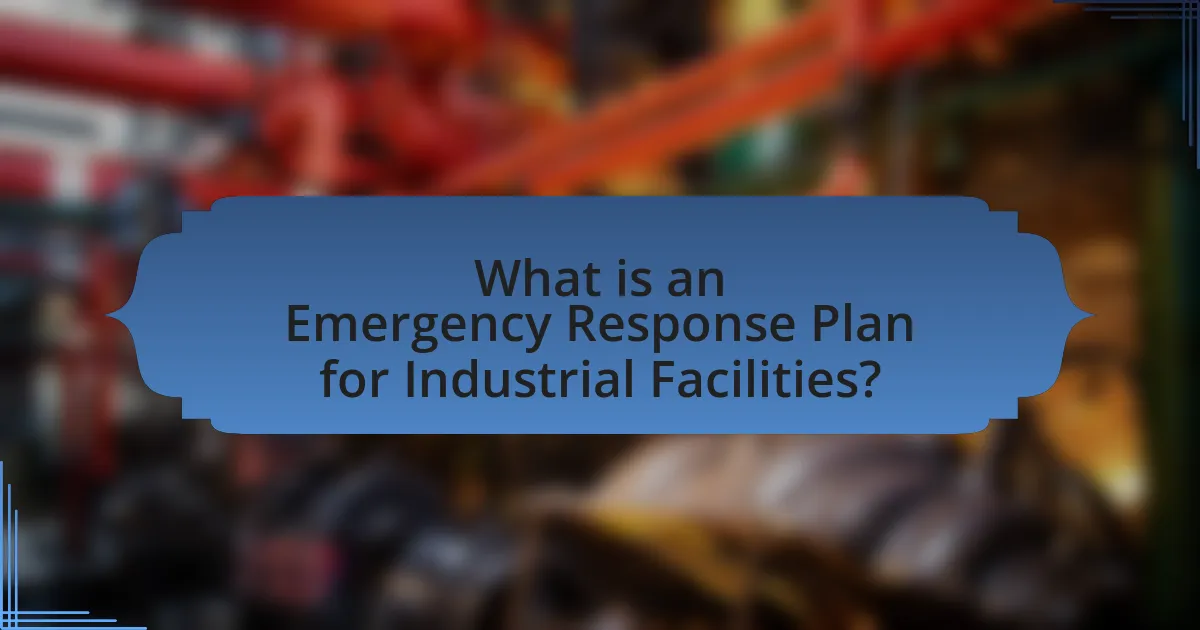An Emergency Response Plan for Industrial Facilities is a structured strategy designed to manage emergencies effectively, ensuring the safety of personnel and minimizing damage to property and the environment. The article outlines the essential components of such plans, including risk assessments, communication protocols, and defined roles for employees during various emergencies. It emphasizes the importance of training and drills in enhancing preparedness and response efficiency, as well as the need for regular reviews and updates to maintain effectiveness. Additionally, the article addresses common challenges in implementation and highlights best practices for continuous improvement and employee involvement in emergency preparedness.
What is an Emergency Response Plan for Industrial Facilities?

An Emergency Response Plan for Industrial Facilities is a documented strategy that outlines procedures and protocols to manage emergencies effectively within industrial settings. This plan typically includes risk assessments, emergency contact information, evacuation routes, and specific roles and responsibilities for employees during an emergency. The implementation of such plans is crucial, as studies indicate that well-prepared facilities can significantly reduce the impact of incidents, ensuring the safety of personnel and minimizing damage to property and the environment.
Why is an Emergency Response Plan essential for industrial facilities?
An Emergency Response Plan is essential for industrial facilities because it provides a structured approach to managing emergencies, ensuring the safety of employees and minimizing damage to property and the environment. Effective plans outline procedures for various scenarios, such as chemical spills or fires, which can significantly reduce response times and improve outcomes. According to the Occupational Safety and Health Administration (OSHA), facilities with comprehensive emergency plans are better equipped to handle crises, leading to a 50% reduction in injury rates during incidents. This underscores the critical role of preparedness in safeguarding lives and assets in industrial settings.
What types of emergencies should be addressed in the plan?
The types of emergencies that should be addressed in the plan include natural disasters, industrial accidents, chemical spills, fires, medical emergencies, and security threats. Each of these emergencies poses specific risks to personnel and operations within industrial facilities. For instance, natural disasters such as earthquakes or floods can disrupt operations and endanger lives, while industrial accidents may involve equipment failures or hazardous material releases. Addressing these emergencies ensures that the facility is prepared to respond effectively, minimizing harm and ensuring safety.
How does an Emergency Response Plan enhance safety in industrial settings?
An Emergency Response Plan enhances safety in industrial settings by providing structured procedures for responding to emergencies, thereby minimizing risks and potential harm. This plan outlines specific roles, responsibilities, and actions to be taken during various emergency scenarios, such as chemical spills, fires, or natural disasters. By having a clear and practiced response strategy, organizations can reduce response times and improve coordination among emergency personnel, which is critical in mitigating the impact of incidents. Studies have shown that companies with well-developed emergency response plans experience fewer injuries and lower financial losses during emergencies, demonstrating the effectiveness of such plans in enhancing overall safety.
What are the key components of an Emergency Response Plan?
The key components of an Emergency Response Plan include risk assessment, emergency procedures, communication protocols, training and drills, resource management, and plan review and improvement. Risk assessment identifies potential hazards and evaluates their impact, ensuring preparedness for various scenarios. Emergency procedures outline specific actions to take during an incident, detailing roles and responsibilities. Communication protocols establish clear lines of communication among responders and stakeholders, facilitating timely information sharing. Training and drills ensure that personnel are familiar with the plan and can execute it effectively. Resource management involves identifying and allocating necessary equipment and personnel for response efforts. Finally, plan review and improvement processes ensure that the plan remains effective and up-to-date based on lessons learned from drills and actual incidents.
What roles and responsibilities should be defined in the plan?
The roles and responsibilities that should be defined in the emergency response plan include the Incident Commander, Safety Officer, Communication Officer, and Response Team Members. The Incident Commander oversees the entire emergency response, ensuring coordination and decision-making during incidents. The Safety Officer is responsible for monitoring safety conditions and ensuring compliance with safety protocols. The Communication Officer manages internal and external communications, providing updates to stakeholders and the public. Response Team Members execute specific tasks as assigned, such as evacuation, first aid, or containment measures. Defining these roles ensures clarity in responsibilities, which is critical for effective emergency management in industrial facilities.
How should communication protocols be established in the plan?
Communication protocols in an emergency response plan should be established by defining clear roles, responsibilities, and channels for information dissemination. This involves identifying key personnel, such as emergency coordinators and team leaders, and specifying how they will communicate during an incident, including the use of radios, phones, or public address systems.
Additionally, protocols should include regular training and drills to ensure all staff are familiar with the communication procedures, which enhances efficiency during an emergency. For instance, the National Fire Protection Association (NFPA) recommends that organizations conduct regular emergency drills to reinforce communication protocols, ensuring that all employees understand their roles and the methods of communication to be used.
How can an Emergency Response Plan be developed effectively?
An Emergency Response Plan can be developed effectively by conducting a thorough risk assessment, establishing clear communication protocols, and providing regular training and drills. The risk assessment identifies potential hazards specific to the industrial facility, allowing for tailored response strategies. Clear communication protocols ensure that all personnel understand their roles and responsibilities during an emergency, facilitating a coordinated response. Regular training and drills reinforce these protocols, ensuring that employees are prepared to act swiftly and effectively in real situations. According to the Occupational Safety and Health Administration (OSHA), effective emergency response plans significantly reduce the impact of emergencies on personnel and operations.
What steps are involved in assessing risks and hazards?
The steps involved in assessing risks and hazards include identifying hazards, analyzing risks, evaluating risks, and implementing control measures. Identifying hazards involves recognizing potential sources of harm in the industrial facility, such as chemicals, machinery, or environmental factors. Analyzing risks entails determining the likelihood and consequences of incidents related to those hazards, often using qualitative or quantitative methods. Evaluating risks involves comparing the analyzed risks against predetermined criteria to prioritize them based on their severity and likelihood. Finally, implementing control measures includes developing strategies to mitigate identified risks, such as engineering controls, administrative procedures, or personal protective equipment. These steps are essential for creating a comprehensive emergency response plan that effectively addresses potential threats in industrial settings.
How can training and drills be integrated into the plan development?
Training and drills can be integrated into the plan development by incorporating them as essential components of the emergency response strategy. This integration ensures that personnel are familiar with the procedures and protocols outlined in the plan, enhancing their readiness and effectiveness during actual emergencies. Regularly scheduled training sessions and drills allow for practical application of the plan, enabling teams to identify gaps, refine processes, and improve coordination. Research indicates that organizations that conduct routine drills experience a 30% increase in response efficiency during emergencies, demonstrating the critical role of training in plan development.
What are common challenges in implementing an Emergency Response Plan?
Common challenges in implementing an Emergency Response Plan include inadequate training, lack of resources, and insufficient communication. Inadequate training can lead to personnel being unprepared for emergencies, as studies show that 70% of employees feel unprepared for emergency situations. Lack of resources, such as equipment and funding, can hinder the effectiveness of the plan, with 60% of organizations reporting budget constraints as a significant barrier. Insufficient communication can result in confusion during emergencies, as effective communication is critical; research indicates that 75% of emergency response failures stem from poor communication.
How can facilities overcome resistance to emergency preparedness?
Facilities can overcome resistance to emergency preparedness by implementing comprehensive training programs that engage employees and demonstrate the importance of preparedness. Engaging employees through hands-on drills and simulations fosters a culture of safety and highlights the practical benefits of being prepared. Research indicates that organizations with regular training and clear communication about emergency protocols experience significantly lower resistance levels, as employees feel more informed and empowered. For example, a study by the National Institute for Occupational Safety and Health found that facilities with proactive training initiatives reported a 30% increase in employee participation in emergency preparedness activities.
What resources are necessary for effective implementation?
Effective implementation of an emergency response plan for industrial facilities requires human resources, financial resources, and technological resources. Human resources include trained personnel who can execute the plan, such as emergency responders and safety officers. Financial resources are necessary to fund training, equipment, and ongoing maintenance of the emergency response systems. Technological resources encompass communication systems, monitoring equipment, and response tools that facilitate quick and efficient action during emergencies. These resources collectively ensure that the emergency response plan is actionable and effective in mitigating risks associated with industrial incidents.
How can the effectiveness of an Emergency Response Plan be evaluated?
The effectiveness of an Emergency Response Plan can be evaluated through regular drills, assessments, and feedback mechanisms. Conducting simulated emergency scenarios allows organizations to test the plan’s procedures and identify areas for improvement. Additionally, analyzing response times, resource allocation, and communication effectiveness during these drills provides concrete data on the plan’s performance. For instance, a study by the National Fire Protection Association found that facilities that regularly conduct drills improve their response times by up to 30%. Furthermore, gathering feedback from participants and stakeholders after each drill helps refine the plan, ensuring it remains relevant and effective in real emergencies.
What metrics should be used to assess the plan’s performance?
Key metrics to assess the performance of an emergency response plan for industrial facilities include response time, incident resolution time, training effectiveness, and compliance rates. Response time measures how quickly the team reacts to an emergency, while incident resolution time evaluates the duration taken to resolve the situation. Training effectiveness can be assessed through drills and simulations, ensuring personnel are adequately prepared. Compliance rates indicate adherence to regulatory requirements and internal protocols, reflecting the plan’s alignment with industry standards. These metrics provide a comprehensive view of the plan’s efficiency and effectiveness in real-world scenarios.
How often should the plan be reviewed and updated?
The plan should be reviewed and updated at least annually. Regular annual reviews ensure that the emergency response plan remains relevant and effective in addressing current risks and compliance requirements. Additionally, any significant changes in operations, regulations, or after an incident should prompt an immediate review and update of the plan to incorporate lessons learned and new safety protocols.
What best practices should be followed when developing an Emergency Response Plan?
Best practices for developing an Emergency Response Plan include conducting a thorough risk assessment, establishing clear communication protocols, and providing regular training and drills for all personnel. A comprehensive risk assessment identifies potential hazards specific to the industrial facility, allowing for tailored response strategies. Clear communication protocols ensure that all employees understand their roles during an emergency, facilitating efficient coordination. Regular training and drills reinforce knowledge and preparedness, as studies show that organizations with frequent practice are more effective in real emergencies. For instance, the National Fire Protection Association emphasizes the importance of training in its guidelines for emergency planning.
How can facilities ensure continuous improvement in their emergency response efforts?
Facilities can ensure continuous improvement in their emergency response efforts by implementing regular training, conducting drills, and reviewing incident reports. Regular training sessions enhance staff preparedness and familiarity with emergency protocols, while drills simulate real-life scenarios, allowing personnel to practice their responses. Reviewing incident reports provides insights into past emergencies, identifying strengths and weaknesses in the response process. According to the National Fire Protection Association, facilities that conduct regular drills and training see a 30% improvement in response times during actual emergencies. This systematic approach fosters a culture of safety and readiness, ultimately leading to more effective emergency response strategies.
What role does employee involvement play in the success of the plan?
Employee involvement is crucial for the success of an emergency response plan in industrial facilities. Engaging employees in the planning process enhances their understanding of procedures, increases compliance, and fosters a culture of safety. Research indicates that organizations with high employee involvement in safety planning experience 30% fewer accidents and improved response times during emergencies. This involvement ensures that employees are not only aware of their roles but also feel a sense of ownership over the plan, leading to more effective implementation and adaptation during actual emergencies.




